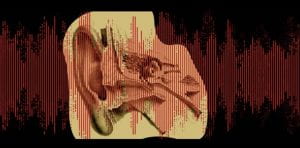This is a personal reflection by Marie. Please note that it discusses the COVID-19 pandemic and a distressing experience of tinnitus.
In mid-March, as the University I work at closed and the UK prepared to go into ‘lockdown’, I began to hear a loud, throbbing bass frequency. After asking my partner several times “can you hear that?’”, it became apparent that the sound was only audible to me. I lay in bed listening to it, then trying not to listen to it. I would play music at it in the hope of driving it away through sound. I hated sitting in silence. But even with sonic distractions, I would sometimes drift into myself, focusing on the bass.
I was scared. This new sound that only I could hear was the latest of a series of strange, uncontrollable things happening to my body. In the beginning of March I developed a cough and was short of breath. I have asthma but it’s mild and ordinarily easy to manage. This wasn’t ordinary, so I went to my GP to visit the asthma nurse. The nurse and I both acknowledged that since I’d not been to China or the Lombardy region of Italy, and since I’d not had a fever and my chest was clear, it was probably ‘nothing’: which is to say, not ‘the virus’. I even preceded the description of my symptoms with ‘I know it’s not coronavirus’: I wanted to assure her I wasn’t wasting valuable NHS time. The official diagnosis was asthma triggered by a mild respiratory infection. I was told to go back if the symptoms hadn’t cleared by the following week. They hadn’t but I didn’t return. Frightened of being considered a hypochondriac, I put it down to the fear and stress of the emerging health crisis. I simply couldn’t be ill, so I must be making myself ill, in line with what I read in the news.
I have tinnitus intermittently: it’s as one might expect—high pitched, sine tone, often exacerbated by going to loud gigs and parties. I find it relatively easy to ignore. It fades in and out of my life, causing little disturbance. The bass frequency was completely different. I joked in public about the ironies of developing what was (for me, at least) a novel form of tinnitus while working on a project about tinnitus. Our project is partly about ‘knowing’ tinnitus: the ways that listeners understand their own tinnitus and what it can ‘tell’ them. Yet, in private, I was becoming increasingly anxious precisely because I had no idea what this new sound meant. Had I given myself tinnitus by reading too much about tinnitus, just as I had given myself a cough and shortness of breath by reading too much about the pandemic?
The explanation I settled on was that this was yet another symptom of stress. A friend reassured me they had experienced something similar. But even with my working explanation, there were still anxiety-inducing not-knowns. Was this now permanent? Would I be able to develop coping strategies? Providing background noise wasn’t doing much while listening to bassy music (which I had initially thought might help) made me all the more distracted: unsure of what I was ‘hearing’, I obsessively monitored the sound in my own head to check whether it was there or not. I was all-too-aware that I was stuck in a feedback loop with the sound: I couldn’t stop listening to it.
Writing this a few months later, after the cough, shortness of breath, tinnitus (and heart palpitations, fatigue, loss of appetite) have subsided, I’m struck by the profound distrust I had in my own body. And I am struck by the dismissiveness I exhibited towards my own psychological distress (I said so many times, to myself and to others, ‘it’s ‘just’ stress’). It may have ‘just’ been stress but the more difficult truth is that I still don’t really know. There are many people who are experiencing tinnitus for the first time or whose tinnitus has been exacerbated during this current extraordinary situation – the British Tinnitus Association now has a section on tinnitus and COVID-19 on their website. Yet there are also multiple accounts by those who have had COVID-19 that list tinnitus as one of the many frightening and unusual symptoms experienced. Like many others, I’m left wondering “was that ‘it’?”
This encounter has also highlighted for me the complexities of researching something you are experiencing yourself. I was essentially frustrated that I couldn’t think this new tinnitus away. While we have sought to question the reduction of tinnitus to the individual listener by highlighting the role of different environmental factors in exacerbating or mitigating it, I struggled to put this knowledge into practice: I couldn’t figure out how to use my sonic environment to muffle the bass sound, nor how to sufficiently distract myself from it. I knew that it was possible to forge different affective relationships with tinnitus but I couldn’t get beyond anxiety and distress. I was reluctant to refer to myself as ‘a tinnitus sufferer’ (I was certainly suffering but to refer to myself in that way seemed to suggest a permanency that I wasn’t willing to entertain) and so was unwilling to pursue the avenues of support that I know to be available. Part of what I encountered, then, was a disjuncture between what I knew through research and what I knew through lived experience. At a time where I was trying to interrogate how tinnitus may serve to generate knowledge – about listening, about sonic environments, about affects, moods and emotions – my own tinnitus amplified what I don’t know.

